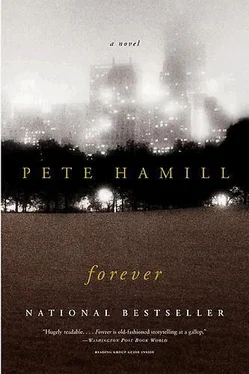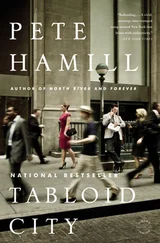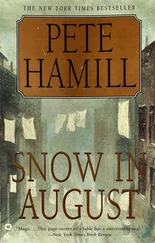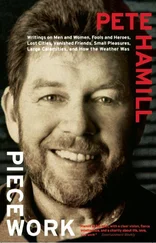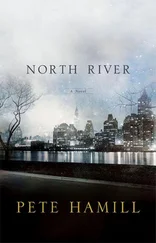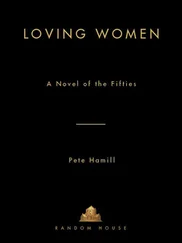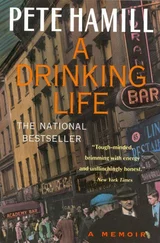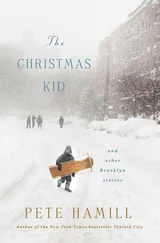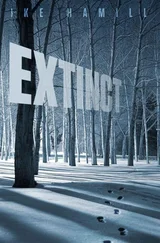Pete Hamill - Forever
Здесь есть возможность читать онлайн «Pete Hamill - Forever» весь текст электронной книги совершенно бесплатно (целиком полную версию без сокращений). В некоторых случаях можно слушать аудио, скачать через торрент в формате fb2 и присутствует краткое содержание. Год выпуска: 2008, ISBN: 2008, Издательство: Paw Prints, Жанр: Современная проза, на английском языке. Описание произведения, (предисловие) а так же отзывы посетителей доступны на портале библиотеки ЛибКат.
- Название:Forever
- Автор:
- Издательство:Paw Prints
- Жанр:
- Год:2008
- ISBN:9781435298644
- Рейтинг книги:4 / 5. Голосов: 1
-
Избранное:Добавить в избранное
- Отзывы:
-
Ваша оценка:
- 80
- 1
- 2
- 3
- 4
- 5
Forever: краткое содержание, описание и аннотация
Предлагаем к чтению аннотацию, описание, краткое содержание или предисловие (зависит от того, что написал сам автор книги «Forever»). Если вы не нашли необходимую информацию о книге — напишите в комментариях, мы постараемся отыскать её.
Reprint. 100,000 first printing.
Forever — читать онлайн бесплатно полную книгу (весь текст) целиком
Ниже представлен текст книги, разбитый по страницам. Система сохранения места последней прочитанной страницы, позволяет с удобством читать онлайн бесплатно книгу «Forever», без необходимости каждый раз заново искать на чём Вы остановились. Поставьте закладку, и сможете в любой момент перейти на страницу, на которой закончили чтение.
Интервал:
Закладка:
She walks around him, looking at him. She pinches the flesh of his arm as if to verify his presence. Then she laughs in a bitter way.
“This is such a bitch,” she says. “I loved you so I could live. And you loved me so you could die.”
She leans down and lifts the cape, angrily shaking away its dust, and slips it over her shoulders with the white shawl beneath it. She picks up a candle.
“I’ll see you, Cormac,” she says, and begins to walk toward the deep part of the cave, the dark unknown place that Kongo pointed to for Cormac.
“Delfina—”
“If you want to die, go ahead,” she says, tossing the words over her shoulder. “I’m just not gonna help.”
Her candle bobs as he goes after her.
“Don’t go there,” he says, his voice echoing now. “That’s the wrong way out. That’s not for you.”
He reaches for her, finds her hand. In the light of the candle, her skin is the color of cinnamon, her eyes liquid with fear and hurt.
“Don’t go there,” he says.
She begins to bawl. A great hopeless weeping, filling the cave. The candle falls and goes out. He holds her, running hands through her hair, caressing her skin, kissing her eyes and ears and mouth, until they fall to the ground, fall upon the cape, fall together, and begin to make love.
“Go,” she whispers, “go. Just go. Please go. Go.”
They rise into each other, joining as one, writhing and weeping and gnashing, obliterating life in the little death. And then breathe as one. And lie silent.
Off in the distance, in the far reaches of the cave, Cormac can see a sliver of emerald light.
He snaps on the flashlight. Her head is turned away from him. He takes the spiral earrings from a pocket. He clips them to her ears.
“Wear these,” he says. “Wear them always.”
“I will,” she says, sitting up and leaning her head to one side and then the other. The earrings dangle in the light, changing shape with each movement of her head. “I’ll always wear them.”
He feels empty now, and free: the story told, the secret revealed. If she has questions, she can ask them now. She asks no questions.
He stands up now, finds the fallen candle, lights it with his lighter. He gazes at her face, its toughness and humor and the way the flicker of candlelight keeps altering her beauty and the way the yellow light glistens on the earrings. Without a word, he takes a breath, picks up the flashlight, and hands it to her. Then he takes the candle and moves into the darkness.
Up there, somewhere, is the entrance. Beyond the jagged stone and the dripping walls. All of them are waiting for him in the emerald light. Some have been waiting for a very long time. His father and his mother, Mr. Partridge and Bill Tweed, Bantu and the black patrol, women and friends, even Bran. He raises the candle and plays the light on the walls. He sees the ceiling lower. He sees a crack that in the distance seems to be an inch wide. He can hear a flute. A damp gust of wind blows out the candle. He moves closer. They are all there, beyond the shimmer of emerald light. All the people he has ever loved.
Except one.
He turns and walks back to Delfina. He reaches down and takes her hand.
“Let’s go, mi amor, ” he says.
“Where?”
“Dancing,” he says. “Let’s go dancing.”
He feels her smooth, pliant hand pulsing with life.
“All right,” she says.
“We can try to find a cab.”
“That would be nice.”
“I love you, mi vida, ” he says.
“But for how long, señor?”
“Forever,” he says, and they start to climb together toward the rain-drowned city.
By way of thanks
This is a work of fiction, an imagined journey through times past and present. But it was stimulated by my own many decades as a New Yorker, by my reporting during four of those decades on the events and people of my native city, and by a lifetime of reading into the extraordinary history of the city itself.
Among the books I cherish, and which helped directly or indirectly in the imagining of this narrative, are the amazing six volumes of The Iconography of Manhattan Island: 1498–1909 by I. N. Phelps Stokes. These were given to me in his last year of life by my friend Edward Robb Ellis, author of The Epic of New York City, which itself remains a fine introduction to our dense, layered history. More than a decade ago, Eddie Ellis urged me to write this novel; I wish I could have handed him his own copy. I will miss him all my days.
I also learned much from Gotham: A History of New York City to 1898, by Edwin G. Burrows and Mike Wallace. This is the first of two volumes, and it is a majestic piece of work. Its dense pages contain the raw material for hundreds of novels and will continue to inspire scholars and writers long after all of us are gone. It’s a book that every New Yorker should read, along with all others who want to understand this very American city.
In addition, The Encyclopedia of New York City, brilliantly edited by Kenneth T. Jackson, is an invaluable resource for all of us who still marvel at the endless complexity of this metropolis.
For many years, the diaries of Philip Hone and George Templeton Strong have helped put me into the New York that has vanished but is still not gone. The novels of Louis Auchincloss and Edith Wharton have helped bring that world to vivid life, elaborating the many generations that were built upon the original templates cut by Strong and Hone. I’ve absorbed all of them in different ways.
My own vision of William M. Tweed was deepened by Oliver E. Allen’s The Tiger: The Rise and Fall of Tammany Hall, Alfred Connable and Edward Silberfarb’s Tigers of Tammany, Leo Hershkowitz’s Tweed’s New York: Another Look, and Denis Tilden Lynch’s “Boss�� Tweed: The Story of a Grim Generation, a 1927 biography with a fierce tabloid energy. The last book was passed to me by my old New York Post editor, Paul Sann, who originally drove me to understand the history of New York while educating me as a reporter.
On the “Great Negro Plot” of 1741, Thomas J. Davis’s A Rumor of Revolt: The “Great Negro Plot” in Colonial New York is indispensable, as is the contemporary report by Daniel Horsmanden called Journal of the Proceedings in the Detection of the Conspiracy Formed by Some White People in Conjunction with Negro and Other Slaves Burning the City of New-York in America and Murdering the Inhabitants. I read the abridged version, edited in 1851 by William B. Wedgwood. Michael G. Kammen’s Colonial New York: A History is a fine work of reconstruction of the years before the American Revolution and helped me with the wider context of 1741.
Many other books fill my New York shelves, from Herbert Asbury’s classic The Gangs of New York to Sean Wilentz’s Chants Democratic . Most recently, I’ve learned from Gerard T. Koeppel’s Water for Gotham, M. H. Dunlop’s Gilded City, and Richard B. Stott’s Workers in the Metropolis . I have hundreds of volumes too on Irish history, too many to list, but some of which provided details of the arctic winter of 1740 and the famine that was forgotten after the much larger horrors of the Great Famine of the 1840s, which changed Ireland and New York for a century.
History is not everything, of course. The poetry and journalism of Walt Whitman are essential for any writer about New York, as are the works of Edgar Allen Poe, Herman Melville, Stephen Crane, and Theodore Dreiser, and, of course, Henry James. But much is to be learned from the pulp fiction produced for more than a century in New York, from the dime novels of the dreadful Ned Buntline and his more respectable contemporaries to the works of the Black Mask school of detective fiction. I admire too the works of Caleb Carr, Jack Finney, and above all, the splendid New York fictions of E. L. Doctorow, who has turned so much of our narrative into high art.
Читать дальшеИнтервал:
Закладка:
Похожие книги на «Forever»
Представляем Вашему вниманию похожие книги на «Forever» списком для выбора. Мы отобрали схожую по названию и смыслу литературу в надежде предоставить читателям больше вариантов отыскать новые, интересные, ещё непрочитанные произведения.
Обсуждение, отзывы о книге «Forever» и просто собственные мнения читателей. Оставьте ваши комментарии, напишите, что Вы думаете о произведении, его смысле или главных героях. Укажите что конкретно понравилось, а что нет, и почему Вы так считаете.
